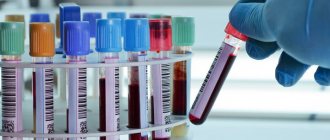What is a glucose tolerance test?
A glucose tolerance test (GTT) is a test to determine the body’s tolerance to glucose (sugar), shows whether all processes are occurring correctly and identifies a predisposition to gestational diabetes. Be sure to prescribe for patients at risk:
- during difficult pregnancy;
- having diabetes mellitus;
- overweight.
GTT is a safe procedure for the mother and child.
But there are contraindications:
- kidney and liver diseases;
- in the presence of infections and viral diseases;
- dumping syndrome;
- endocrine system problems;
- when taking certain medications;
- after 32 weeks of term.
If a woman in labor is prescribed bed rest, then the test is not done at this time, but only at the end of it, if there are no other contraindications.
Glucose levels during pregnancy: interpretation of test results
Interpretation of test results is based on data obtained as a result of three measurements of the level of glucose in the blood. When assessing the result obtained, you can rely on the following criteria:
1. Indicators of blood sugar concentration when collecting biological material on an empty stomach and without load are:
- below 5.1 - 5.5 mmol/l (taking into account laboratory reference values) is normal;
- in the range of 5.6 - 6.0 mmol/l - deviations in glucose tolerance;
- 6.1 mmol/l or more - suspicion of diabetes (in a number of laboratories this indicator is in the range of 7 mmol/l and above).
2. Measuring glucose incorporation 60 minutes after an additional carbohydrate load:
- less than 10 mmol/l is normal;
- in the range of 10.1 - 11.1 mmol/l - deviations in glucose tolerance;
- 11.1 mmol/l or more - suspected diabetes.
3. Fixing the sugar content 120 minutes after a glucose load:
- less than 8.5 mmol/l indicates normal;
- in the range of 8.6 - 11.1 mmol/l - deviations in glucose tolerance;
- 11.1 mmol/l and above is a clear deviation, possibly gestational diabetes.
Table for assessing glucose levels during pregnancy: norm and deviations
Depending on the type of research method, the normal limits in different laboratories may vary slightly
In view of this, it is very important to evaluate the result solely in accordance with the criteria of a given research center.
Analysis result: increased glucose during pregnancy
Even if the test results reveal a discrepancy with the normal criteria, you should not immediately panic. This violation may be due to:
- Increased hormonal activity of the adrenal glands.
- Excessive activity of the thyroid gland.
- Pathologies of the pancreas.
- Long-term use of glucocorticoids.
Additional examinations will help clarify the cause of the violations.
Test result: low glucose during pregnancy
A downward deviation is less common than an elevated glucose level. This violation may be associated with:
- Severe form of early toxicosis.
- Unbalanced diet of the expectant mother.
- Lack of body weight in a pregnant woman.
A low sugar content, in addition to disturbing the general condition, can also lead to increased production of ketone bodies, which have a toxic effect on the female body. Drug therapy for low sugar levels is not prescribed. A woman is advised to eat a balanced diet with sufficient calories. In some cases, glucose drips may be prescribed.
Why during pregnancy
GTT is necessary to determine predisposition to gestational diabetes, which develops during pregnancy. The body is overloaded and cannot cope with metabolic reactions, and as a result, a disease develops. It is dangerous for the mother and the child. The peculiarity of the disease is the absence of symptoms, so it is extremely difficult to notice it without conducting an examination. If treatment is ignored, after the birth of a child, the disease can develop into manifest type 2 diabetes mellitus.
In the 1st trimester
The first trimester is fundamental; the laying and formation of the child’s organs and vital systems occurs.
The placenta begins to actively develop, but does not yet have high protective functions, which is why harmful elements and substances can reach the fetus. That is why in the first weeks you need to listen especially carefully to the signals of the body, to any changes. GTT is not done at the beginning of pregnancy, it is pointless. Insulin resistance in pregnant women increases only in the middle of pregnancy. The doctor can prescribe the earliest GTT starting from the sixteenth week of pregnancy.
In the second trimester
Optimal time for the procedure. The best range is 24-26 weeks of pregnancy. But if certain factors are present, there is a need for an earlier test:
- excess body weight;
- history of difficult pregnancies;
- sugar in urine;
- diabetes mellitus in close relatives;
- large fruit;
- increased blood glucose levels.
Is it done in the third trimester?
In the last weeks, GTT is done strictly as prescribed by the treating doctor. After 32 weeks, an additional glucose load is unsafe for the baby, so this is the deadline.
How to donate blood for sugar during pregnancy
A specialist can obtain biological material from a finger or vein.
After drawing blood, you need to dissolve glucose in water and drink it. After 2 hours, blood is drawn again. During this period, sugar is completely absorbed by the body.
Normally, there should be no traces of glucose in the samples . The indicators are within acceptable limits. If, after exerting stress, a pregnant woman’s glucose level is high, the doctor sends the patient for a repeat test.
Hidden diabetes in a pregnant woman can be detected using specific tests. They are prescribed if hidden sugar has been detected in the blood. During the blood donation process, the doctor selects the most appropriate type of test.
What should a pregnant woman not eat or drink?
To protect themselves as much as possible from the development of diabetes in the event of pregnancy, doctors recommend that women pay special attention to their health. . Pregnant women need to follow certain recommendations:
Pregnant women need to follow certain recommendations:
- do not drink sweet carbonated drinks, natural fruit juices;
- limit the consumption of rice, buckwheat, potatoes, pasta;
- do not eat carbohydrates that are quickly absorbed (sugar, sweets, confectionery, mashed potatoes).
Creating a diet for a pregnant woman who suffers from diabetes is not an easy task. After all, nutrition should provide the fetus with all the necessary substances and beneficial microelements. Therefore, you should trust the preparation of your diet only to an experienced nutritionist.
Minimizing physical activity
Although increased physical activity is contraindicated for pregnant women, it is recommended to maintain optimal mobility if you have diabetes.
Moderate daily exercise minimizes plasma glucose levels.
Accordingly, the need for insulin is also minimized
However, it is important to remember that too sudden changes in physical activity can lead to decompensation of the disease.
If the doctor has not recommended bed rest, the patient should try to maintain moderate activity.
After consulting with your doctor, you can take up swimming, yoga or Pilates. Another useful recommendation is to go for walks more often.
Elimination of medications
As noted above, the result of the study may be distorted due to the woman taking medications.
The prescription or, conversely, withdrawal of any drug may be accompanied by a significant change in laboratory parameters.
Therefore, before taking the test, you need to consult with your doctor about the possible exclusion of the drug (at least for the duration of the test).
Before donating blood, in most cases doctors recommend stopping the use of medications.
What else could affect the results?
An increase in blood sugar generally indicates the presence of diabetes in a woman. However, a specialist makes this diagnosis after undergoing additional studies.
Increased blood sugar levels may also be caused by:
- epilepsy;
- disturbances in the functioning of the pancreas;
- overstrain (emotional or physical);
- diseases of the pituitary gland, adrenal glands, and thyroid gland.
Despite the fact that pregnant women donate blood for sugar in the laboratory, you can check this indicator yourself, at home. To do this, just use a special one.
A portable device designed to determine blood sugar levels is at the disposal of every diabetic.
However, this method of measurement often exhibits failures (incorrect indicators). Accordingly, to obtain reliable results it is necessary to undergo this procedure in laboratory conditions.
How to prepare for tests
Venous blood is used for the test.
The patient needs to prepare for the analysis. For several days before the GTT, you should not engage in physical activity that requires great effort.
What not to eat
On the eve of the examination, you need to reduce the amount of fatty foods. But, in general, you should not change your diet much, otherwise this may cause an incorrect result. The amount of carbohydrates consumed is at least 150 g per day. Eight hours before the test, you are prohibited from eating, only plain water. Consumption of alcohol and cigarettes is not allowed.
If the patient uses medications, it is necessary to notify the specialist in advance. He must adjust the dose of medications to ensure that the test results are not affected.
When is it available, what time of day?
The examination takes place in the morning. The procedure takes several hours, so this time of day is most preferable.
Normal glucose levels during pregnancy
Normal blood sugar value - if it is taken on an empty stomach:
- from the finger – 3.3-5.8 mmol/l;
- from the vein – 4.0-6.3 mmol/l.
The indicator under load is no more than 7.8 mmol/l. The load is drinking sugar in water based on the patient’s weight.
If blood is taken, regardless of when the patient ate, then the value should be more than 11.1 mmol/l.
In the 1st and 3rd trimesters, it is acceptable for the sugar level to be slightly higher than normal - by 0.2 mmol/l. Under load, a value below 8.6 mmol/l is considered normal. Test results may vary between laboratories.
The emotional state and general well-being have an unfavorable effect and disrupt the outcome during pregnancy. Therefore, if the indicator is exceeded once, there is no need to worry - you just need to donate blood again in a calm state.
If the indicator during pregnancy is below 3 mmol/l, it is also necessary to take measures - a lack of glucose can disrupt the development of the child’s brain in the womb.
How do pregnant women take a glucose test?
Blood is donated for sugar without any preparation from a finger or vein, in the morning, on an empty stomach.
If you need to test urine for glucose, it is collected for 24 hours, and a portion of about 150-200 g is delivered to the laboratory.
Load analysis is carried out in several stages:
- First, a simple blood test is taken from a vein. If the sugar level is elevated, then the test is completed, and the pregnant woman is diagnosed with gestational diabetes.
- When the indicator is at the normal level, the tolerance test is continued. The patient drinks a glucose solution - 75-80 g of pure substance is dissolved in one glass of plain water. Blood sampling is then carried out three times with pauses of an hour. This test is also called O'Sullivan.
Before testing for glucose during pregnancy, you need to prepare for it.
Preparing for the GTT test
3 days before the test, a woman should consume at least 150 g of net carbohydrates per day. 10-12 hours before the test you need to stop eating. You can only drink plain water without sweeteners. During this time, you should also refrain from taking medications - if possible, discussing all the consequences with your doctor.
It is strictly forbidden to smoke or drink alcoholic beverages, however, hardly anyone does this during pregnancy.
The condition for the reliability of the indicator is physiological rest. During the analysis, a pregnant woman is not recommended to move actively, and it is also advisable to refrain from emotional experiences.
You need to take some light reading with you - a computer game can stimulate brain stimulation.
The sweet solution has a characteristic taste, cloying to the point of disgust - it is difficult to drink, vomiting and nausea may occur, especially in early pregnancy.
In some laboratories, instead of a sweet drink, women are offered to eat a baked potato with a piece of black bread sprinkled with sugar.
Of course, this makes the indicator close to reliable.
The result can be distorted if there is a lack of magnesium or potassium in the body, with endocrine disorders and after stress.
Contraindications for glucose tolerance testing during pregnancy
The GTT test is not performed:
- with pancreatitis in the acute stage;
- for liver dysfunction and gallbladder diseases;
- with dumping syndrome;
- for erosive lesions of the digestive organs - peptic ulcers, Crohn's disease, etc.;
- with exacerbation of chronic and the emergence of infectious diseases.
Also, a tolerance test is not performed if bed rest is prescribed during pregnancy and for acute toxicosis, regardless of the time of occurrence.
If this analysis was not prescribed before the 3rd trimester, then it may not be done later - after 32 weeks the indicator will be uninformative.
How is blood tested for impaired glucose tolerance?
The examination procedure takes a couple of stages:
- On an empty stomach, blood is taken from a vein and an analysis is done. If the glucose level is increased, then the patient has gestational diabetes. The test is completed and the woman in labor is sent to the attending doctor with the results of the analysis.
- When the result is satisfactory, the indicators are normal, the patient should drink a glass of glucose (75 g of dry glucose diluted with 200-300 ml of warm water). An hour later, the doctor takes blood from the vein again.
- If the indicators are stable and do not exceed the permissible norm, the test can be repeated after two or three hours - this is called the O'Sullivan test.
The results of the study are immediately reported to the patient.
How is the analysis carried out?
First, blood is drawn.
Then the woman is given about 50–75 milliliters of glucose diluted in a glass of water to drink. For some pregnant women, this becomes a real challenge - the cloyingly sweet taste can even provoke vomiting. To reduce the likelihood of such a reaction, lemon juice can be added to the water. After taking glucose, a pregnant woman waits one hour. Physical activity is prohibited, as is food intake.
“Just drink glucose water” through the eyes of a pregnant woman
An hour later, the laboratory technician takes the blood again. The results of both samples are then compared. If at least one of the indicators is above the norm, the analysis is re-administered. If the results are similar, the pregnant woman is referred to an endocrinologist. The latter gives all the necessary recommendations, following which will avoid risks to the health of the mother and child.
The stress test differs in that after taking the solution, blood is taken three times with pauses of 1 hour.
In addition to blood, urine may also be tested for glucose. You need to bring about 150–200 milliliters of liquid collected during the day to the laboratory.
If GTT is reduced: reasons
A low rate is also not the norm and poses a danger to the woman and child. Glucose plays an important role in nutrition, so levels are checked periodically during pregnancy. Low sugar is rare, called glycemia, and this is facilitated by:
- severe toxicosis;
- poor nutrition;
- disorders in the gastrointestinal tract.
With acute glucose deficiency, the patient's condition deteriorates sharply and the question of terminating the pregnancy may arise. You need to take this problem seriously and follow your doctor’s recommendations.
How to take the test correctly
It is recommended to donate blood in the morning (between 8 and 11 o’clock), strictly on an empty stomach (at least 8 and no more than 14 hours of fasting, you can drink water). Avoid food overload the day before.
- During the 3 days preceding the day of the glucose tolerance test, you must adhere to a normal diet without restricting carbohydrates; exclude factors that can cause dehydration of the body (insufficient drinking regimen, increased physical activity, the presence of intestinal disorders).
- Three days before the study, you must refrain from taking medications, the use of which may affect the results of the study (salicylates, oral contraceptives, thiazides, corticosteroids, phenothiazine, lithium, metapyrone, vitamin C, etc.).
- Attention! Cancellation of medications is carried out only after preliminary consultation of the patient with a doctor!
- Drinking alcohol is contraindicated 24 hours before the test.
- The glucose tolerance test is not performed on children under 14 years of age.
What to do if the GTT level is increased
If the glucose level is elevated, a pregnant woman needs to constantly monitor the amount of sugar in her blood, adhere to a diet and perform special physical exercises.
Sometimes the patient is prescribed insulin therapy. Diet rules for gestational diabetes:
- drink at least 1.5 liters of water daily;
- Fried, sweet, spicy, fatty foods are prohibited;
- exclude fast food;
- Do not use sauces: mayonnaise, ketchup;
- focus on foods containing fiber;
- Recommended lean meat: turkey, chicken;
- Divide meals into 5-6 times, three main meals and snacks.
Hyperglycemia indicators and norms
Blood sugar levels range from 3.3 to 6.6 mmol per liter. It is necessary to maintain sugar levels within these limits when expecting a child, otherwise a special type of diabetes may develop - gestational. It is he who turns into type 2 diabetes after childbirth (this does not always happen, but quite often).
Sugar levels in pregnant women undergo significant changes due to the fact that the number of ketone bodies increases, while the number of amino acids decreases. But in the second - third trimester (with normal gestation), insulin secretion increases. These are the reasons why blood sugar levels are stable.
-FOOTNOTE-
At week 28, doctors prescribe a stress blood sugar test. The exercise test involves taking 50 ml of glucose on an empty stomach. Sugar is measured after one hour. The normal blood sugar level for pregnant women in this study is 7.8. If it is higher, we can say that sugar is increased during pregnancy and diabetes develops.
Interpretation of indicators according to the table
| Venous whole blood glucose concentration mg/dL | Whole capillary blood | Venous plasma | |
| Diabetes | |||
| On an empty stomach | >6,1(110) | >6,1(110) | >7,0(126) |
| Two hours after taking glucose | >10,0(180) | >11,1(200) | >11,1(200) |
| Impaired glucose tolerance | |||
| On an empty stomach | <6,1(110) | <6,1(110) | <7,0(126) |
| Two hours after taking glucose | <6,7(120)< <10(180) | >7,8(140)< <11,1(200) | >7,8(140)< <11,1(200) |
| Increased fasting plasma glucose levels | <5,6(100)< <6,1(110) | >5,6(100) < <6,1(110) | >6,1(110) < <7,0(126) |
| Norm | |||
| On an empty stomach | <5,6(100) | <5,6(100) | <6,1(110) |
| After taking glucose | <6,7(120) | <7,8(140) | <7,8(140) |
Normally, the glucose level is 7 mmol/l and slightly lower. Exceeding this level means the development of gestational diabetes in the patient.
After taking the sweet solution, the indicators should increase sharply, and after a two-hour period they return to normal, if there are no pathologies.
The normal indicators vary and are very arbitrary, so a specialist makes a conclusion about the patient’s condition.
Management of patients with GDM
Within 1–2 weeks after diagnosis, the patient is advised to be monitored by obstetricians-gynecologists, therapists, and general practitioners.
Rules for conducting an oral glucose tolerance test (OGTT)
- The test is carried out against the background of normal nutrition. At least 150 g of carbohydrates should be consumed per day for at least three days before the study.
- The last meal before the test should contain at least 30–50 g of carbohydrates.
- The test is performed on an empty stomach (8–14 hours after eating).
- Drinking water before the test is not prohibited.
- You are not allowed to smoke during the study.
- The patient must sit during the test.
- If possible, on the eve of and during the study, it is necessary to avoid taking medications that can change blood glucose levels. These include multivitamins and iron supplements, which contain carbohydrates, as well as corticosteroids, beta blockers, beta adrenergic agonists.
- OGTT should not be performed:
- with early toxicosis of pregnant women;
- if necessary, on strict bed rest;
- against the background of an acute inflammatory disease;
- with exacerbation of chronic pancreatitis or resected stomach syndrome.
Recommendations for a pregnant woman with diagnosed GDM according to the Russian national consensus:
- Individual correction of the diet depending on the woman’s body weight and height. It is recommended to completely eliminate easily digestible carbohydrates and limit the amount of fat. Food should be distributed evenly over 4-6 meals. Non-nutritive sweeteners can be used in moderation.
For women with a BMI >30 kg/m2, average daily caloric intake should be reduced by 30–33% (approximately 25 kcal/kg per day). This measure has been proven to reduce hyperglycemia and plasma triglyceride levels.
- Aerobic physical activity: walking at least 150 minutes per week, swimming.
- Self-monitoring of key indicators:
- glucose level in capillary blood on an empty stomach, before meals and 1 hour after meals;
the level of ketone bodies in urine in the morning on an empty stomach (before bedtime or at night, it is recommended to additionally take carbohydrates in an amount of about 15 g for ketonuria or ketonemia);
- arterial pressure;
- fetal movements;
- body mass.
In addition, the patient is recommended to keep a self-monitoring diary and a food diary.
What to do
With gestational diabetes, a woman needs to regularly visit a doctor and take tests to monitor blood glucose, plus:
- balanced diet;
- moderate physical activity;
- blood pressure control;
- maintaining a daily routine and a healthy lifestyle.
In some cases, it is necessary to take medications, prescribed by the attending doctor. The expectant mother can take insulin, but it is also strictly according to the recommendations and it is imperative to measure the amount of glucose with a special device - a glucometer.
Tablets that help lower sugar are prohibited for pregnant women!
If glucose is low during pregnancy
A decrease in glucose levels is usually observed in cases where the pancreas has produced a large amount of insulin, but little sugar has entered the body. This condition is called hypoglycemia and is expressed in a sharp drop in blood glucose levels.
There may be several reasons for this condition:
- Too long breaks between meals when consuming small portions. In this case, all the energy received will be completely consumed within a few hours after lunch or dinner.
- Eating low-calorie foods in very small quantities . In this case, too little energy enters the body and the sugar level often drops sharply after all the glucose has been completely used up. This type of hypoglycemia is caused by malnutrition and requires urgent adjustment of not only the menu, but also the diet, as well as the inclusion of foods with a low glycemic index in the diet.
- Intense sports activities , during which the body quickly uses up all the energy received. If it is impossible to refuse to play sports while pregnant (which usually applies to professional athletes), then you should additionally consume carbohydrates, for example, ascorbic acid with glucose during pregnancy can perfectly solve this problem.
- Frequent consumption of sweets or other foods with a high glycemic index. At the same time, the blood sugar level rises sharply, provoking increased production of insulin for its absorption. As a result of such actions, the glucose level drops very quickly and sharply, causing a feeling of fatigue, weakness, drowsiness and the desire to eat more candy or sweet cookies, as the need arises. This situation can lead to further abuse of sweets and various baked goods.
- Alcoholic and carbonated drinks . Such drinks contain a lot of sugar, and therefore can sharply increase its content in the blood, but at the same time, the glucose level will quickly and sharply drop in the future.
Dangerous moments
High glucose levels are dangerous throughout pregnancy, both for the woman and the child. Provokes the following diseases and abnormalities in the fetus:
- hypoxia, respiratory dysfunction;
- jaundice;
- lack of magnesium and calcium in the blood;
- violation of proportions;
- large fruit size.
For a woman in labor, the disease is dangerous:
- polyhydramnios;
- complications throughout pregnancy;
- dysfunction of the cardiovascular system;
- provokes the development of infectious diseases of the genital tract, which also affects the intrauterine development of the child;
- miscarriage, premature birth;
- development of diabetes mellitus after childbirth.
Due to the fact that the fetus is generally larger than normal, delivery is possible only with the help of cesarean luminescence.
One of the important points is the patient’s condition after childbirth. It is necessary to carefully monitor glucose levels to prevent the development of diabetes.
Carrying a child is a difficult and difficult period in a woman’s life. It is important to pay timely attention to your health and not ignore the doctor’s recommendations and undergo prescribed procedures. The glucose tolerance test is one of the most important and safe for the expectant mother and child.
High glucose level
Increased glucose during pregnancy
In a healthy person, blood glucose is controlled by insulin, which is produced by the pancreas. It is under the influence of this hormone that glucose moves from food into the cells of the body and a decrease in its level in the blood is observed.
During pregnancy, the placenta produces hormones whose action is opposite to insulin and a gradual increase in sugar occurs. During pregnancy, the load on the pancreas increases greatly and often it begins to fail to cope with its functions. The result of this is an increase in glucose levels in a pregnant woman, which can cause undesirable consequences.
If the level of glucose in the blood increases, the result is a disruption of metabolic processes both in the body of the mother and her unborn child.
This is due to the fact that glucose is able to penetrate through the placenta into the circulatory system of the fetus, which causes an increase in the load on the work of its pancreas.
In such a situation, the fetal pancreas begins to function with increased load and produce even more insulin. Under the influence of excess insulin, the process of glucose absorption and its conversion into fat is significantly accelerated, which explains the accelerated growth of the unborn child’s body weight. Such metabolic processes require a large amount of oxygen, which is why fetal hypoxia develops.
Causes and symptoms
Features of the development of gestational diabetes during pregnancy
Gestational diabetes is considered one of the common pathologies diagnosed during pregnancy.
Most often, expectant mothers who experience:
- obesity
- development of diabetes in a previous pregnancy
- detection of sugar in urine
- development of polycystic ovary syndrome
- detection of diabetes mellitus and close relatives
The risk of developing diabetes mellitus is significantly reduced if:
- The age of the expectant mother is less than 25 years
- before pregnancy the weight was normal and the woman is not obese
- There are no relatives with diabetes mellitus
- the woman has no history of elevated blood sugar
- previous pregnancies proceeded without any complications
Useful video - Glucose during pregnancy.
//www.youtube.com/embed/csk2biW2ymA?wmode=transparent&modestbranding=1&autohide=1&showinfo=0&rel=0″>
If a woman belongs to a risk group, her likelihood of developing diabetes mellitus increases significantly. Most often, this pathology is diagnosed in patients with a genetic predisposition to the development of such a disease, as well as when pregnancy occurs after 35 years.
Experts advise potential mothers to pay attention to the appearance of certain symptoms, which may indicate the development of diabetes. . The following characteristic signs of this pathology can be identified:
The following characteristic signs of this pathology can be identified:
- a woman's appetite increases
- having problems urinating
- there is a constant desire to drink
- there is a constant feeling of weakness
If such symptoms appear, a woman is advised to seek help from a specialist who will carry out the necessary blood tests and.
Answers to questions close to the topic
Along with questions regarding blood sugar levels, expectant mothers are interested in why an analysis is performed for its content in the urine, what is glucosuria, is it possible and in what cases should glucose be taken?
Taking glucose during pregnancy
Is glucose harmful for pregnant women?
No. It is the main supplier of energy for the body. Another thing is that it should not be consumed in its pure form. The price of such “strengthening” and uncontrolled “feeding” can be deplorable.
Let everything happen naturally. Eat, but again in moderation, fruits, vegetables, legumes, cereals, pasta - foods containing carbohydrates, which during the process of fermentation (digestion) break down into glucose.
During pregnancy and breastfeeding, completely avoid sweet soda.
Then why should pregnant women drink glucose and can pregnant women take ascorbic acid with glucose?
- Firstly, pregnant women drink a glucose solution: 75 mg of its tablet form per 300 ml of water - when undergoing GTT.
- Secondly, a drip with ascorbic acid along with glucose may be prescribed.
It is placed strictly according to indications:
- In the first trimester - if there is a threat of miscarriage, but only after the formation of the corpus luteum. Until this time, it is recommended to enhance the menu with citrus fruits and other foods containing large amounts of carbohydrates and vitamin C.
- In the second and third trimester, glucose along with ascorbic acid and saline are administered intravenously when:
- acute and severe toxicosis;
- gestosis;
- uterine bleeding (to stop it).
In addition, an ascorbic-glucose drip placed on the eve of labor will help increase tissue elasticity and avoid extensive ruptures and bleeding.
Thirdly, there is such a combination as actovegin glucose during pregnancy. It is prescribed to maintain the normal course of pregnancy during the development of placental insufficiency. It significantly improves uteroplacental blood flow, thereby eliminating oxygen and nutritional starvation of the fetus.
About the analysis
Glucose is the only source of energy and nutrition for red blood cells, which are responsible for supplying the human brain with blood. Glucose enters the body when eating food that contains carbohydrates. They are found not only in sweets, but also in natural products: fruits, berries, vegetables.
Once in the blood, carbohydrates are broken down and converted into sugar. A constant level of glucose is maintained by a special hormone called insulin, which is produced in the pancreas. Its quantity can be checked by testing for sugar . For normal brain function, 5 grams of sugar is enough in the body.
During gestation, the organic processes inside the body of the expectant mother may be disrupted. Increased hormonal load during pregnancy affects the balance of carbohydrate metabolism and sometimes causes deviations from the norm. The concentration of glucose in the blood increases or decreases, and insulin is no longer able to control sugar in the body. The resulting imbalance can trigger the development of gestational diabetes mellitus .
Indications
A referral for analysis can be issued by an endocrinologist, nephrologist, gastroenterologist, pediatrician, surgeon, or therapist.
A glucose tolerance test is prescribed in the following cases:
- glucosuria (increased sugar levels in the urine) in the absence of symptoms of diabetes mellitus and normal blood glucose levels;
- clinical symptoms of diabetes, but blood and urine sugar levels are normal;
- examination of patients with risk factors for diabetes: age over 45 years,
- body mass index BMI more than 25 kg/m2,
- arterial hypertension,
- lipid metabolism disorder;
- thyrotoxicosis (increased secretion of thyroid hormones from the thyroid gland);
GTT is also performed in patients with sensory neuropathy in conjunction with vitamin B12 testing to differentiate diabetic neuropathy from other types of neuropathies1.
Note: the level of C-peptide is of great importance, which allows you to assess the degree of functioning of cells that secrete insulin (islets of Langerhans). Thanks to this indicator, the type of diabetes mellitus (insulin-dependent or independent) and, accordingly, the type of therapy used are determined.
An oral glucose tolerance test allows you to diagnose various disorders of carbohydrate metabolism, such as diabetes mellitus, impaired glucose tolerance, fasting glycemia, but cannot clarify the type and causes of diabetes mellitus, and therefore, after receiving any result, it is advisable to conduct additional examination2:
- C-peptide,
- serum insulin,
- .
When is it worth performing GTT?
| Age | Health status | Periodicity |
| over 45 years old |
|
|
| over 16 years old |
|
|
How to calculate BMI
BMI=(weight, kg) : (height, m)2
Cases when a glucose tolerance test is not performed
GTT is not advisable to carry out in the following cases
- recent heart attack or stroke;
- recent (less than 3 months) surgery;
- end of the 3rd trimester in pregnant women (preparation for childbirth), childbirth and the first time after it;
- preliminary blood biochemistry showed a sugar content of more than 7.0 mmol/l.
- against the background of any acute disease, including infectious.
- while taking medications that increase glycemic levels (glucocorticoids, thyroid hormones, thiazides, beta blockers, oral contraceptives).
What is a glucose telarant test?
This is a test that all pregnant women undergo without exception. With its help, you can diagnose diabetes mellitus and even a tendency to it in a timely manner. And this, in turn, helps to assess the situation and adjust the management of pregnancy.
Pregnancy is the time when all the sores, all the weak points of the expectant mother can come out, because the load on the body as a whole and on each internal organ separately is truly colossal. Gestational diabetes (which did not exist before pregnancy and which arose during this period) is just one of these diseases. It happens quite rarely: official statistics state that such diabetes occurs in no more than 4% of all pregnant women officially registered in clinics.
Contraindications to performing GTT
Not everyone can take a glucose tolerance test during pregnancy.
There is no point in performing it because the test results will be distorted if:
- have individual glucose intolerance;
- toxicosis is worsening;
- a pregnant woman suffers from an infectious disease;
- there is no possibility of canceling medications that affect test results;
- there is a relapse of chronic diseases of the liver, pancreas, stomach, erosive pathologies of the gastrointestinal tract;
- The pregnant woman is prescribed strict bed rest.
Norm and deviations
For clarity, the results obtained during OGTT are noted on a sugar curve - a graph where glycemic indicators are marked on the vertical scale (usually in mmol/l), and time is marked on the horizontal scale: 0 - on an empty stomach, after 1 hour and after 2 hours.
It is not difficult to decipher the sugar curve compiled according to GTT data during pregnancy. The diagnosis of GDM is made if the blood glucose level according to OGTT is:
- on an empty stomach ≥5.1 mmol/l;
- 1 hour after taking 75 g glucose ≥10.0 mmol/l;
- 2 hours after taking a glucose solution ≥8.5 mmol/l.
Normally, according to the sugar curve, there is an increase in the glycemic level 1 hour after oral administration of glucose to no more than 9.9 mmol/l. Next, there is a decrease in the curve graph, and blood sugar numbers should not exceed 8.4 mmol/l.
It is important to note that during pregnancy a diagnosis of “impaired carbohydrate tolerance” or “latent diabetes mellitus” is not made.
Danger to the fetus
If all rules are followed, a glucose tolerance test during pregnancy is safe for the unborn child. That is why expectant mothers should not refuse the test. Why do they do it? The expected benefit from the examination is much higher than the expected risk.
Possible harm to the fetus is associated with analysis with existing contraindications. Acute hyperglycemia during the test can contribute to temporary oxygen starvation of the unborn child. However, such an outcome is possible against the background of concomitant type 2 diabetes.
Reasons for deviations of results from the standard
The glucose tolerance test is a 2-hour detailed study, in which the results of the reactions of the pancreas to the received glucose are recorded at different time intervals. This allows us to establish the presence of a significant number of pathologies and diseases of different systems of the female body.
Any deviations to a smaller or larger direction indicate certain violations.
The glucose value may increase as a result of the study (hyperglycemia) in the presence of the following ailments:
- DM and its progression;
- ailments of the endocrine organs;
- diseases of the pancreas - chronic or acute pancreatitis;
- all kinds of kidney and liver diseases.
If the sugar level decreases (hypoglycemia), we can assume the presence of:
- various abnormalities in the functioning of the pancreas;
- hypothyroidism;
- liver diseases;
- drug, alcohol poisoning;
- iron deficiency anemia.
Since the test results are quite susceptible to a variety of factors, additional studies are prescribed to confirm the diagnosis.
Methodology of the procedure
There are two main methods for conducting this test. A glucose tolerance test during pregnancy can be performed either by intravenous administration of glucose solution or by oral administration.
The oral test is more convenient and practical, since it does not require special training of medical personnel, the use of systems for intravenous administration of drugs or any other means.
The essence of the oral method is this: before the test, the patient is told what she is about to undergo and the fasting blood sugar level is determined. After this, the woman is given a glass of warm sugar syrup to drink (approximately 75-80 g of sugar or glucose per 200 ml of water). During the test, you are prohibited from being nervous, performing any intense physical activity, or consuming various foods or medications.
For 2 hours, every half hour, capillary blood is examined for sugar content. The data obtained is entered into a special graph, which displays the time after taking sugar and its level in the blood. Based on these data, a special sugar curve is constructed, and when assessing its indicators, the state of the patient’s body and its reaction to glucose consumption are determined.
Intravenous administration of glucose is carried out much less frequently, since with this technique it is somewhat more difficult to determine the peak concentration of sugar in the blood due to its massive administration. In addition, patients tolerate this procedure worse, not to mention the fact that with intravenous administration the risk of fetal damage increases.
The study itself can be carried out either on an outpatient basis (in a clinic) or in a hospital setting. If the patient has her own glucometer, the procedure can be performed at home.
Why is it dangerous?
The analysis itself is not dangerous. This applies to the no-load test.
In relation to exercise testing, it is possible to “overdose” blood sugar levels. This happens only when the pregnant woman already has a high glucose level, but there will be symptoms that clearly indicate a violation of carbohydrate metabolism.
OGTT is not carried out just like that. During pregnancy with stress, the test is performed a maximum of 2 times and only in case of serious suspicion of diabetes. While blood is donated once a trimester without fail, so the blood sugar level can be found out without additional stress.
Eat different fruits
Like any medical procedure, GTT has a number of contraindications, including:
- congenital or acquired glucose intolerance;
- exacerbation of chronic stomach diseases (gastritis, disorders, etc.);
- viral infections (or pathologies of another nature);
- severe toxicosis.
In the absence of individual contraindications, the test is safe even during pregnancy. In addition, judging by the reviews, it does not present any particular discomfort when performed.
Women describe a glucose cocktail as “just sweet water,” which is easy to drink. Of course, if the pregnant woman does not suffer from toxicosis. The need to draw blood 3 times within two hours leaves a slight discomfort.
However, in most modern clinics (Invitro, Helix), blood is taken from a vein completely painlessly and does not leave any unpleasant impressions, unlike most municipal medical institutions. Therefore, if there are any doubts or concerns, it is better to take the test for a fee, but with the proper level of comfort.
Don't worry - everything will be fine
In addition, you can always administer glucose intravenously, but to do this you need to inject it again. But you won't have to drink anything. Glucose is introduced gradually over 4-5 minutes.
Testing is contraindicated for children under 14 years of age. For them, it is carried out exclusively by drawing blood without being burdened by a glucose load.
mirror belly table pregnant analysis fruits passed
The volume of the sweet cocktail taken is also different. If the child weighs less than 42 kg, the dose of glucose is reduced.
Thus, the test does not pose a threat if you prepare properly and follow the instructions. And undiagnosed diabetes poses a danger to the fetus and mother.
Proper metabolism, including carbohydrate metabolism, is important for the development of the fetus and for the mother’s body during pregnancy. The detected pathology is subject to correction, which will certainly be prescribed by the observing obstetrician-gynecologist.
Having gestational diabetes complicates pregnancy and future births
Therefore, it is so important to register it at the initial stage and make changes that help normalize blood sugar levels and minimize the harm from the disease.
Therefore, when prescribing this test, expectant mothers should not worry, but pay due attention to the test. After all, prevention is the best treatment, especially when we are talking not about one life, but about two at the same time
Why does diabetes develop?
During pregnancy, the female body undergoes significant changes. There is some suppression of her immune system for the normal development and functioning of the fetus in the womb (physiologically, the fetus is perceived as an antigen, therefore immune resistance is reduced to prevent a rejection reaction).
As for the condition of the pancreas and the insulin it synthesizes, the body becomes less susceptible to this hormone. A similar phenomenon has been observed since the beginning of the second trimester of pregnancy.
It is because of this that a sufficiently large amount of glucose can be detected in the mother’s blood, which is why a diagnosis of gestational diabetes is made.
How is a glucose tolerance test performed during pregnancy?
Types of GTT
The glucose tolerance test can be carried out in various ways:
- Parenteral (glucose solution is administered intravenously).
- Oral (the patient takes glucose orally). There are 3 methods of performing an oral test:
- screening - the subject takes a certain dose of glucose, after which an hour later the level of glycemia (blood sugar) is measured;
- two-hour - the glycemic indicator is measured first on an empty stomach, then twice with an interval of 1 hour after oral glucose intake; this option is the most convenient and indicative;
- three-hour - the glucose level is measured on an empty stomach, then three times with an interval of 60 minutes after the subject takes a glucose solution orally.
The amount of glucose taken can be different: 50 g, 75 g, 100 g.
Contraindications to the oral glucose tolerance test
GTT cannot be performed in the following cases:
- ARI, acute respiratory viral infections, acute respiratory infections and other infectious and inflammatory diseases;
- acute or chronic (in the acute stage) diseases of the pancreas;
- postgastrectomy syndrome (dumping syndrome);
- any conditions accompanied by disruption of the movement of food masses through various parts of the digestive system;
- conditions requiring strict limitation of physical activity;
- early toxicosis (nausea, vomiting).











